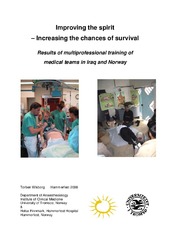Studies of sleep and seasonal variations in patients with chronic musculoskeletal pain
Permanent link
https://hdl.handle.net/10037/20702View/
Date
2021-04-19Type
Doctoral thesisDoktorgradsavhandling
Author
Abeler, KarinAbstract
Background/aims: Chronic pain is a major health problem, and contributing factors include poor sleep and mental distress. In the subarctic city of Tromsø, clinical impression also suggests worse pain in winter. We aimed to examine whether sleep in patients with chronic musculoskeletal pain differs from pain-free controls, and how psychological processes are related to sleep in these groups. We also examined day-to-day associations between sleep and pain as well as seasonal variations in symptoms.
Methods: We assessed self-reports of pain, sleep quality, insomnia, mental distress, and pain catastrophizing, and recorded 1 week of actigraphy and 1 night of home polysomnography (PSG) in patients and controls. Patients were examined both during summer and winter.
Results: Group differences indicating worse sleep in patients than in controls were large in sleep quality and insomnia, and small to medium in actigraphy and PSG measures. Mental distress was strongly related to more severe insomnia symptoms and reduced sleep quality in both groups and explained group differences in these measures. Pain catastrophizing was associated with less slow-wave sleep (SWS), and thus potentially less restorative sleep, in patients only. A weak reciprocal association between daytime pain and sleep quality was observed. Finally, patients reported slightly more pain and experienced delayed sleep timing in summer compared to winter.
Conclusion: Mental distress was related to worse self-reported sleep quality and insomnia, whereas pain catastrophizing was related to less SWS. In a clinical setting, sleep complaints may therefore be best addressed in a broader context including affective and cognitive functions. The daily reciprocal associations between sleep and pain, and seasonal variations in pain, sleep, and mental distress were minor. However, sleep timing was significantly delayed in summer and may be a target for circadian adjustment in some patients.
Has part(s)
Paper I: Abeler, K., Friborg, O., Engstrøm, M., Sand, T. & Bergvik, S. (2020). Sleep characteristics in adults with and without chronic musculoskeletal pain: The role of mental distress and pain catastrophizing. Clinical Journal of Pain, 36(9), 707-715. Published version not available in Munin due to publisher’s restrictions. Published version available at https://doi.org/10.1097/AJP.0000000000000854. Accepted manuscript version available in Munin at https://hdl.handle.net/10037/20766.
Paper II: Abeler, K., Sand, T., Friborg, O. & Bergvik, S. (2020). Seasonality in pain, sleep and mental distress in patients with chronic musculoskeletal pain at latitude 69°N. Chronobiology International, 37(11), 1650-1661. Published version not available in Munin due to publisher’s restrictions. Published version available at https://doi.org/10.1080/07420528.2020.1764011. Accepted manuscript version available in Munin at https://hdl.handle.net/10037/20765.
Paper III: Abeler K., Bergvik S., Sand T., & Friborg O. (2020). Daily associations between sleep and pain in patients with chronic musculoskeletal pain. Journal of Sleep Research, e13237. Also available at https://doi.org/10.1111/jsr.13237. Accepted manuscript version available in Munin at https://hdl.handle.net/10037/20767.
Related research data
Data collected for this thesis have been archived in Services for sensitive data (TSD) at the Universty of Oslo.Publisher
UiT The Arctic University of NorwayUiT Norges arktiske universitet
Metadata
Show full item recordCollections
The following license file are associated with this item:
Related items
Showing items related by title, author, creator and subject.
-
The Temporomandibular Joint in Juvenile Idiopathic Arthritis, focusing on Quality of Life, Oral Microbiome and Intervention
Frid, Paula (Doctoral thesis; Doktorgradsavhandling, 2020-10-02)The temporomandibular joint (TMJ) is commonly involved in juvenile idiopathic arthritis (JIA), and may lead to impaired mouth opening, pain and facial growth disturbances. Asymptomatic TMJ arthritis may be diagnosed late in the disease course, thus management is challenging. The overall objectives of this thesis were to provide new knowledge on quality of life (QoL), the oral microbiome and interventions ... -
Diagnostics and management of infective endocarditis post-transcatheter aortic valve implantation - A systematic review
Martyn, Piriyanthi Carolini (Master thesis; Mastergradsoppgave, 2021-05-31)Background: As transcatheter aortic valve implantation (TAVI) has expanded the treatment options to otherwise inoperable patients, it has become as prevalent as surgical aortic valve replacement. TAVI infective endocarditis (IE) has thereby become a feared complication. IE is heterogenous in its presentation, identifying characteristics and diagnostic criteria among these patients is crucial in ... -
Improving the spirit – increasing the chances of survival : results of multiprofessional training of medical teams in Iraq and Norway
Wisborg, Torben (Doctoral thesis; Doktorgradsavhandling, 2008-05-30)This work is a synthesis of experiences gained during ten years of helping healthcare providers improve their service to victims of injury and acute disease. This work is based on my participation in two programs: The Trauma Care Foundation’s Mine Injury Management Program in Kurdistan, northern Iraq, and the BEST Foundation: Better & Systematic Trauma Care’s trauma team training program in Norwegian ...


 English
English norsk
norsk



